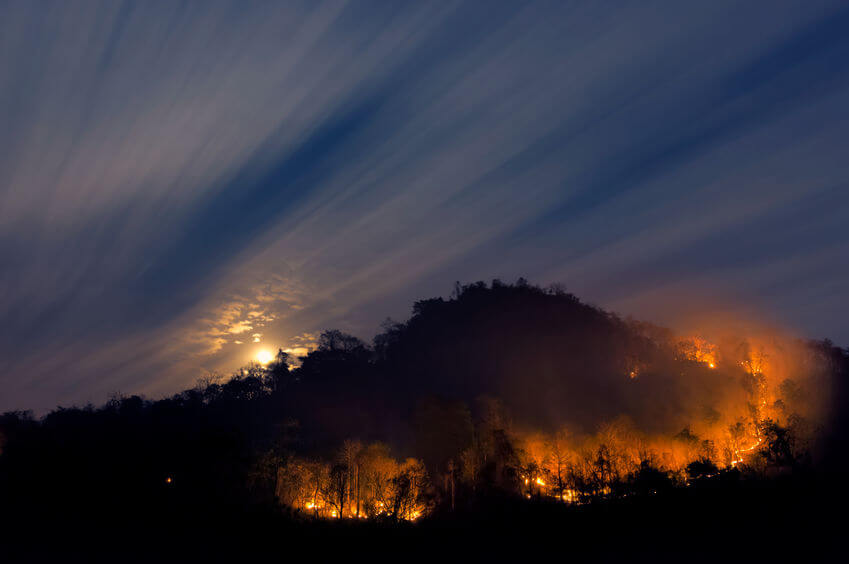How do I protect my home from wildfires near me?

As of today – September 10, 2021, wildfires have burned 5.26 million acres in 2021*. This is almost exactly the same number of acres burned by the same data last year. 4% less (an insignificant difference) than last year to be exact. More importantly, losses from wildfires is on the rise, and the increase is rapid. This has many homeowners asking, “how do I protect my home and family from wildfires near me?”
An important first step in protecting yourself and your belongings is to have good insurance. Get a free rating on car and auto insurance by clicking the buttons below.
States With the Greatest Wildfire Risk
When considering how likely a wildfire is of damaging your home or property, it’s important to consider the percentage of properties at risk in a given area. For that reason, we break down the percentage of properties considered to be “at risk” by Verisk Analytics.
Montana – 29%
Idaho – 26%
Colorado – 17%
California – 15%
New Mexico 15%
Utah – 14%
Wyoming – 14%
Oklahoma – 9%
Oregon – 9%
Arizona – 8%
Verisk Wildfire Risk Analytics
These numbers are shockingly high. In Montana, nearly one out of three properties is considered at risk. In Idaho, one out of four. While California is significantly less than these states with an at risk exposure of one out of seven homes, the financial risk in California is much greater for insurers due to both the number of homes and the high value of homes.
How do I reduce the risk of wildfires near me?
If you’re in one of the states listed above, you have a high risk of wildfire damage. Additionally, if you live a forest or wildland area, you also may at high risk of a wildfire that could damage your property. We referred to the Federal Emergency Management Agency (FEMA) for this list of actions that can reduce the risk of a wildfire near me.
Thin vegetation near your home
30 foot radius – keep the volume of vegetation to a minimum
100 foot radius – reduce as much flammable vegetation as possible
If you live on a hill, extend these distances on the downhill side. Fire spreads rapidly uphill
Move combustible materials away from the house
Firewood
Grill for cooking
Enclose the area under porches and decks
Enclosed areas trap heat and embers and are highly combustible
Items stored under decks and porches increase the risk of fire
Enclose eves and overhangs – like porches and decks, open eves and overhangs trap embers and heat, creating ideal conditions for a fire.
Cover vents with a wire mesh – this will prevent embers from a fire from entering the home
Have a roof made of non-combustible material – The roof is especially vulnerable to flying embers.
Chimneys and stove pipes need to be covered with spark arrestors – burning embers emitted from a chimney can cause a fire.
Build the home with a siding material that is fire resistant – stucco, stone brick, etc.
Treat windows to reduce fire risk – thermal pane glass and fire resistant shutters are both good options.
If You’re Reading This Post on “Wildfires Near Me” be Sure to Have Good Insurance
Typically, people would not read a post on “wildfires near me” unless they feel they’re in a high risk area. Therefore, anyone reading this post probably needs to make sure they have good insurance.
ValChoice has analyzed insurance companies for nearly a decade. We’ve watched how companies respond after catastrophic events. We know which companies are best and which are worst. We make this information available to consumers for free.
There are a few important points about insurance for wildfires.
Make sure you have adequate coverage. Wildfires can destroy everything. If you’re underinsured, the insurance company will not pay more than the amount of coverage you purchased.
Adequate coverage to rebuild the home
Coverage for your belongings is separate from rebuilding the structure
Adequate living expense. Temporary living could be on a relatively long-term basis since contractors will likely be busy after a major wildfire. Make sure your allowance for temporary housing is sufficient.
Be sure to buy insurance from a good company. We publish the best insurance companies in every state.
Find the Best Insurance Companies
Click the buttons below for the best auto insurance companies and best home insurance companies. Shop with any of these companies to find a fair price and excellent coverage.
For the ten states with the highest risk of property damage, we list links directly to the best insurance companies in each of these states. That saves you the time of navigating through another page to find the best insurance companies for getting the wildfire protection needed.
About ValChoice Ratings
ValChoice rates every car and home insurance company. Ratings are based on data filed with state departments of insurance. Data collection occurring by state insurance departments is important for two reasons: 1) The data is high quality. 2) ValChoice does not depend on data provided by insurance companies to rate them.
Current updates on wildfire status can be found on the National Fire Information Center website.
About Dan Karr
Dan has been a CEO or Vice President for high-technology companies for over 20 years. While working as a Senior Vice President of Marketing and Sales for a technology company, Dan was seriously injured while commuting to work. After dealing with trying to get insurance companies to pay his significant medical bills, or to settle a claim so Dan could pay the medical bills, he became intimately aware of the complexity of insurance claims. Dan founded ValChoice to pay forward his experience by bringing consumers, insurance agents and financial advisors easy-to-understand analysis needed to know which insurance companies provide the best price, protection — claims handling — and service.







